Chapter: Essentials of Anatomy and Physiology: Human Development and Genetics
Genetics
GENETICS
Genetics is the study of inheritance. Most, if not vir-tually all, human characteristics are regulated at least partially by genes. We will first look at what genes are, then describe some patterns of inheritance.
CHROMOSOMES AND GENES
Each of the cells of an individual (except mature red blood cells and egg and sperm cells) contains 46 chro-mosomes, the diploid number. These chromosomes are in 23 pairs called homologous pairs. One mem-ber of each pair has come from the egg and is called maternal, the other member has come from the sperm and is called paternal. The autosomes are the chromo-some pairs designated 1 to 22. The sex chromosomes form the remaining pair. In women these are desig-nated XX and in men XY.
Chromosomes are made of DNA and protein; the DNA is the hereditary material. The sequence of bases in the DNA of chromosomes is the genetic code for proteins, structural proteins as well as enzymes. The DNA code for one protein is called a gene. For example, a specific region of the DNA of chromosome 11 is the code for the beta chain of hemoglobin. Because an individual has two of chro-mosome 11, he or she will have two genes for this pro-tein, a maternal gene inherited from the mother and a paternal gene inherited from the father. This is true for virtually all of the 20,000 to 25,000 genes estimated to be found in our chromosomes. In our genetic makeup, each of us has two genes for each protein.
GENOTYPE AND PHENOTYPE
For each gene of a pair, there may be two or more pos-sibilities for its “expression,” that is, how it will appear or how it will affect the individual. These possibilities are called alleles. A person, therefore, may be said to have two alleles for each protein or trait; the alleles may be the same or may be different.
If the two alleles are the same, the person is said to be homozygous for the trait. If the two alleles are dif-ferent, the person is said to be heterozygous for the trait.
The genotype is the actual genetic makeup, that is, the alleles present. The phenotype is the appearance, or how the alleles are expressed. When a gene has two or more alleles, one allele may be dominant over the other, which is called recessive. For a person who is heterozygous for a trait, the dominant allele (or gene) is the one that will appear in the phenotype. The recessive allele (or gene) is hidden but is not lost, and may be passed to children. For a recessive trait to be expressed in the phenotype, the person must be homozygous recessive, that is, have two recessive al-leles (genes) for the trait.
An example will be helpful here to put all this together and is illustrated in Fig. 21–7. When doing genetics problems, a Punnett square is used to show the possible combinations of genes in the egg and sperm for a particular set of parents and their children. Remember that an egg or sperm has only 23 chromo-somes and, therefore, has only one gene for each trait.
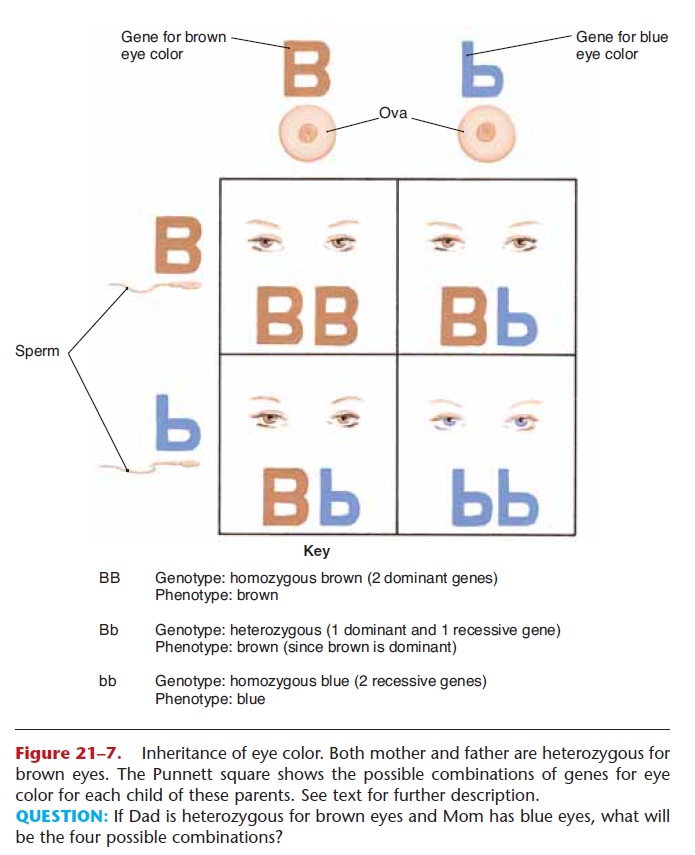
Figure 21–7. Inheritance of eye color. Both mother and father are heterozygous for brown eyes. The Punnett square shows the possible combinations of genes for eye color for each child of these parents. See text for further description.
QUESTION: If Dad is heterozygous for brown eyes and Mom has blue eyes, what will be the four possible combinations?
In this example, the inheritance of eye color has been simplified. Although eye color is determined by many pairs of genes, with many possible phenotypes, one pair is considered the principal pair, with brown eyes dominant over blue eyes. A dominant gene is usu-ally represented by a capital letter, and the correspon-ding recessive gene is represented by the same letter, but lowercase. The parents in Fig. 21–7 are both het-erozygous for eye color. Their genotype consists of a gene for brown eyes and a gene for blue eyes, but their phenotype is brown eyes.
Each egg produced by the mother has a 50% chance of containing the gene for brown eyes, or an equal 50% chance of containing the gene for blue eyes. Similarly, each sperm produced by the father has a 50% chance of containing the gene for brown eyes and a 50% chance of containing the gene for blue eyes.
Now look at the boxes of the Punnett square; these represent the possibilities for the genetic makeup of each child. For eye color there are three possibilities: a 25% (one of four) chance for homozygous brown eyes, a 50% (two of four) chance for heterozygous brown eyes, and a 25% (one of four) chance for homozygous blue eyes. Notice that BB and Bb have the same phenotype (brown eyes) despite their differ-ent genotypes, and that the phenotype of blue eyes is possible only with the genotype bb. Can brown-eyed parents have a blue-eyed child? Yes; if each parent is heterozygous for brown eyes, each child has a 25% chance of inheriting blue eyes. Could these parents have four children with blue eyes? What is the proba-bility or chance of this happening?
INHERITANCE: DOMINANT–RECESSIVE
The inheritance of eye color just described is an exam-ple of a trait determined by a pair of alleles, one of which may dominate the other.
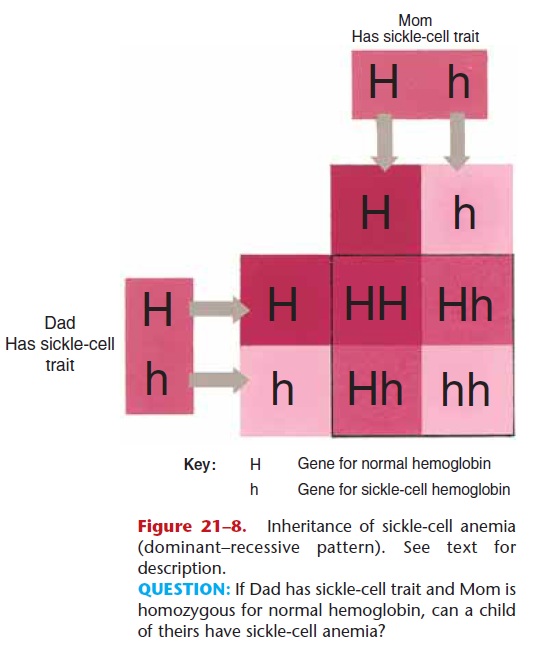
Figure 21–8. Inheritance of sickle-cell anemia (dominant–recessive pattern). See text for description.
QUESTION: If Dad has sickle-cell trait and Mom is homozygous for normal hemoglobin, can a child of theirs have sickle-cell anemia?
11. The gene for the beta chain of hemoglobin is on chromosome 11; an allele for normal hemoglobin is dominant, and an allele for sickle-cell hemoglobin is recessive. An individual who is heterozygous is said to have sickle-cell trait; an individual who is homozygous recessive will have sickle-cell anemia. The Punnett square in Fig. 21–8 shows that if both parents are het-erozygous, each child has a 25% chance (1 of 4) of inheriting the two recessive genes. Table 21–4 lists some other human genetic diseases and their patterns of inheritance.
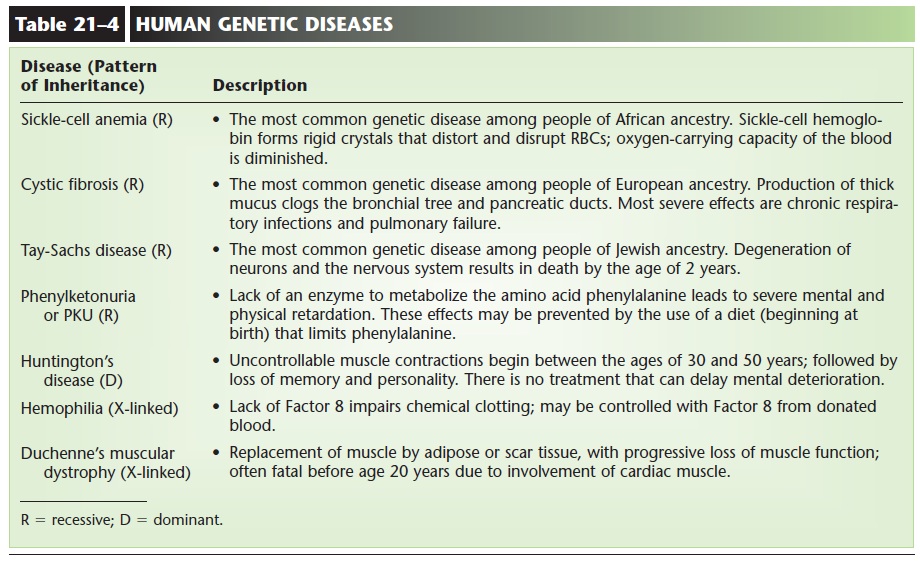
It is important to remember that in the terminol-ogy of genetics, dominant does not mean “common” or “frequent.” It simply means that one gene is suffi-cient for the characteristic to appear in the phenotype. Think back to the ABO blood types. Which type is the most common in a population? Type O is most com-mon, followed by type A, then type B. Type AB is the least common. Here is an instance in which the reces-sive trait, type O, is most frequent in a group of peo-ple. Why is type AB the least common, even though A and B alleles are dominant over an O allele? Because there are not many B alleles to be found in a popula-tion; not many people have a B allele. If you look at Table 21–6 later, you will certainly be able to find other dominant traits that are rare.
INHERITANCE: MULTIPLE ALLELES
The best example of this pattern of inheritance is the human blood type of the ABO group. For each gene of this blood type, there are three possible alleles: A, B, or O. A person will have only two of these alleles, which may be the same or different. O is the recessive allele; A and B are co-dominant alleles, that is, domi-nant over O but not over each other.
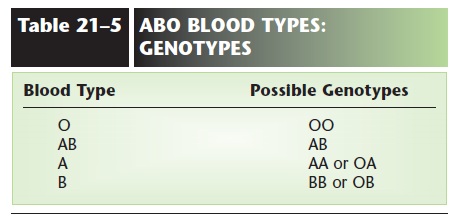
You already know that in this blood group there are four possible blood types: O, AB, A, and B. Table 21–5 shows the combinations of alleles for each type. Notice that for types O and AB there is only one pos-sible genotype. For types A and B, however, there are two possible genotypes, because both A and B alleles are dominant over an O allele.
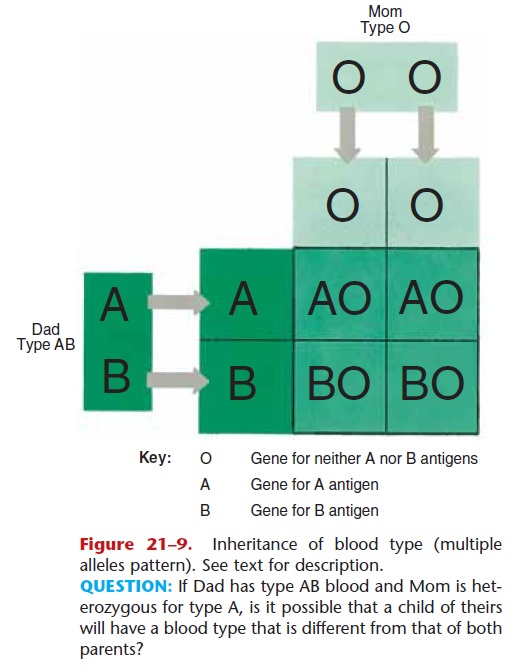
Figure 21–9. Inheritance of blood type (multiple alleles pattern). See text for description.
QUESTION: If Dad has type AB blood and Mom is het-erozygous for type A, is it possible that a child of theirs will have a blood type that is different from that of both parents?
Let us now use a problem to illustrate the inheri-tance of blood type. The Punnett square in Fig. 21–9 shows that Mom has type O blood and Dad has type AB blood. The boxes of the square show the possible blood types for each child. Each child has a 50% chance of having type A blood, and a 50% chance of having type B blood. The genotype, however, will always be heterozygous. Notice that in this example, the blood types of the children will not be the same as those of the parents. (The Rh factor is inherited inde-pendently of the ABO type, and is of the dominant– recessive pattern. Rh positive is dominant and Rh negative is recessive.)
Table 21–6 lists some other human genetic traits, with the dominant and recessive phenotype for each.
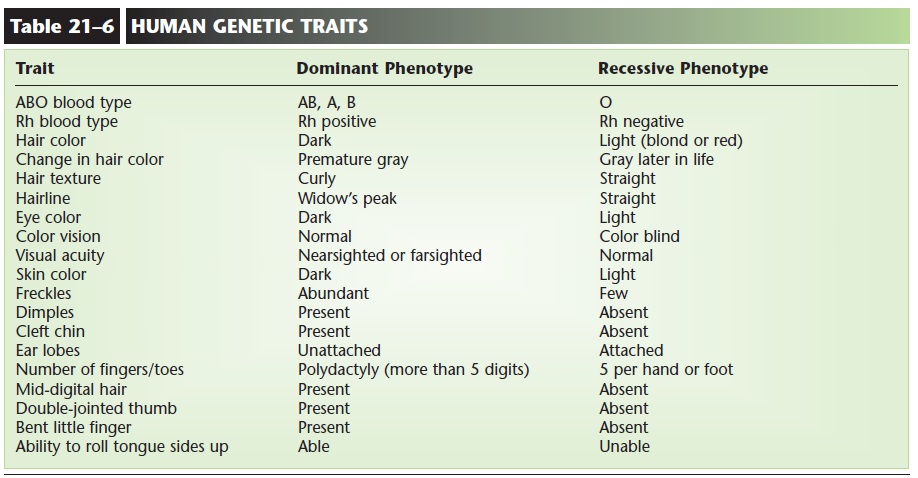
INHERITANCE: SEX-LINKED TRAITS
Sex-linked traits may also be called X-linked traits because the genes for them are located only on the X chromosome. The Y does not have corresponding genes for many of the genes on the X chromosome. (The Y chromosome is very small and has only about 20 genes. Some of these genes are active only in the testes and contribute to spermatogenesis. Others are active in many body cells, but their functions are not yet known with certainty.)
The genes for sex-linked traits are recessive, but because there are no corresponding genes on the Y chromosome to mask them, a man needs only one gene to express one of these traits in his phenotype.
A woman who has one of these recessive genes on one X chromosome and a dominant gene for normal func-tion on the other X chromosome will not express this trait. She is called a carrier, however, because the gene is part of her genotype and may be passed to children.
Let us use as an example, red-green color blind-ness. The Punnett square in Fig. 21–10 shows that Mom is carrier of this trait and that Dad has normal color vision. A Punnett square for a sex-linked trait uses the X and Y chromosomes with a lower case let-ter on the X to indicate the presence of the recessive gene. The possibilities for each child are divided equally into daughters and sons. In this example, each daughter has a 50% chance of being a carrier and a 50% chance of not being a carrier. In either case, a daughter will have normal color vision. Each son has a 50% chance of being red-green color blind and a 50% chance of having normal color vision. Men can never be carriers of a trait such as this; they either have it or do not have it.

Figure 21–10. Inheritance of red-green color blindness (sex-linked pattern). See text for description.
The inheritance of other characteristics is often not as easily depicted as are the examples just discussed. Height, for example, is a multiple gene characteristic, meaning that many pairs of genes contribute. Many pairs of genes result in many possible combinations for genotype and many possible phenotypes. In addition, height is a trait that is influenced by envi-ronmental factors such as nutrition. These kinds of circumstances or influences are probably important in many other human characteristics.
Of the estimated 20,000 to 25,000 human genes, almost all have been “mapped.” This means that they have been precisely located on a particular chromo-some. There is still much work to be done, however, and the focus now is on learning what each of these
genes is for; that is, the protein the gene codes for and the function of that protein.
Someday it will be possible to cure genetic diseases by inserting correct copies of malfunctioning genes into the cells of affected individuals. As of 2006, cer-tain immune deficiencies (which previously would have been fatal) seem to have been reversed in several children by supplying correct copies of their faulty genes. But these early successes have not been repli-cated, and replication of results is an essential part of the scientific method. Research must proceed slowly, because human beings are the subjects, and so that any potential risks of such therapy may be assessed and reduced.
Other diseases that may eventually be cured or controlled with gene therapy include cystic fibrosis and hemophilia (for both of which clinical trials are continuing), Parkinson’s disease, diabetes, muscular dystrophy, and sickle-cell anemia. Much more research and careful experimentation remain to be done before gene replacement becomes the standard treatment available to everyone with these genetic dis-eases. This is a good example of how science must work when results fall short of expectations. Researchers and clinicians must pause and reevaluate the underlying principles of their work and the meth-ods they have chosen, decide what changes are neces-sary, and try again.
Related Topics